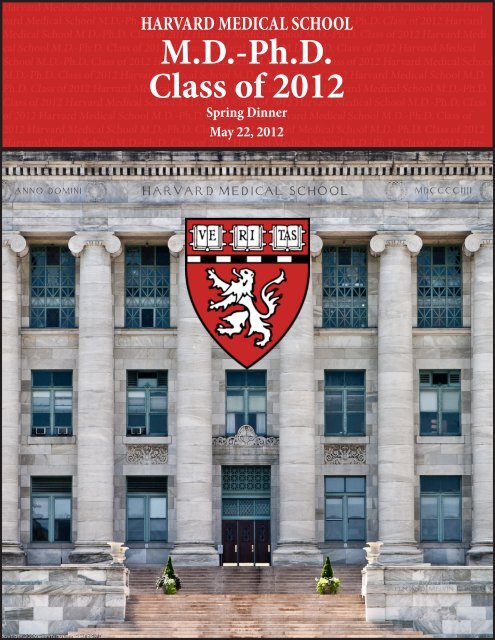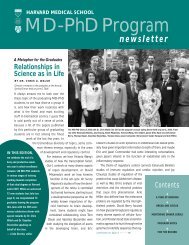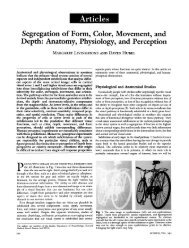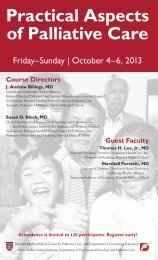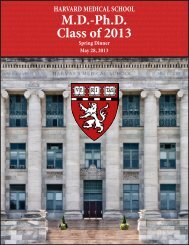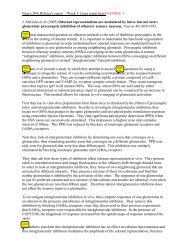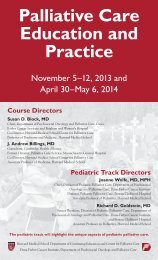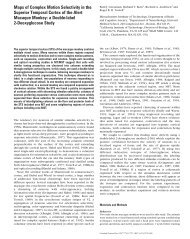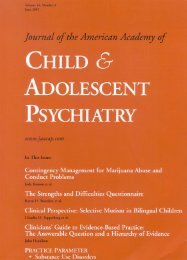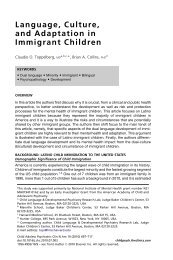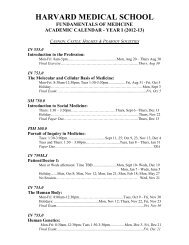MD-Ph.D. Class of 2012 - Harvard Medical School - Harvard University
MD-Ph.D. Class of 2012 - Harvard Medical School - Harvard University
MD-Ph.D. Class of 2012 - Harvard Medical School - Harvard University
Create successful ePaper yourself
Turn your PDF publications into a flip-book with our unique Google optimized e-Paper software.
<strong>Harvard</strong> <strong>Medical</strong> <strong>School</strong> M.D.-<strong>Ph</strong>.D. <strong>Class</strong> <strong>of</strong> <strong>2012</strong> <strong>Harvard</strong> <strong>Medical</strong> <strong>School</strong> M.D.-<strong>Ph</strong>.D. <strong>Class</strong> <strong>of</strong> <strong>2012</strong> <strong>Harvard</strong><strong>Medical</strong> <strong>School</strong> M.D.-<strong>Ph</strong>.D.HARVARD<strong>Class</strong> <strong>of</strong> <strong>2012</strong> <strong>Harvard</strong>MEDICAL<strong>Medical</strong>SCHOOL<strong>School</strong> M.D.-<strong>Ph</strong>.D. <strong>Class</strong> <strong>of</strong> <strong>2012</strong> <strong>Harvard</strong><strong>Medical</strong> <strong>School</strong> M.D.-<strong>Ph</strong>.D. <strong>Class</strong> <strong>of</strong> <strong>2012</strong> <strong>Harvard</strong> <strong>Medical</strong> <strong>School</strong> M.D.-<strong>Ph</strong>.D. <strong>Class</strong> <strong>of</strong> <strong>2012</strong> <strong>Harvard</strong> <strong>Medical</strong><strong>School</strong> M.D.-<strong>Ph</strong>.D. <strong>Class</strong> <strong>of</strong> <strong>2012</strong> <strong>Harvard</strong> <strong>Medical</strong> <strong>School</strong> <strong>Class</strong> <strong>of</strong> <strong>2012</strong> <strong>Harvard</strong> <strong>Medical</strong>M.D.-<strong>Ph</strong>.D.<strong>School</strong> M.D.-<strong>Ph</strong>.D. <strong>Class</strong> <strong>of</strong> <strong>2012</strong> <strong>Harvard</strong> <strong>Medical</strong> <strong>School</strong> <strong>Class</strong> <strong>of</strong> <strong>2012</strong> <strong>Harvard</strong> <strong>Medical</strong> <strong>School</strong>M.D.-<strong>Ph</strong>.D. <strong>Class</strong> <strong>of</strong> <strong>2012</strong> <strong>Harvard</strong><strong>Class</strong><strong>Medical</strong> <strong>School</strong> M.D.-<strong>Ph</strong>.D.<strong>of</strong> <strong>2012</strong><strong>Class</strong> <strong>of</strong> <strong>Harvard</strong> <strong>Medical</strong> <strong>School</strong> M.D.-<strong>Ph</strong>.D. <strong>Class</strong> <strong>of</strong> <strong>2012</strong> <strong>Harvard</strong> <strong>Medical</strong> <strong>School</strong> M.D.-<strong>Ph</strong>.D. <strong>Class</strong> <strong>of</strong> <strong>Harvard</strong> <strong>Medical</strong> <strong>School</strong> M.D.-<strong>Ph</strong>.D.<strong>Class</strong> <strong>of</strong> <strong>2012</strong> <strong>Harvard</strong> <strong>Medical</strong> <strong>School</strong> M.D.-<strong>Ph</strong>.D. <strong>Class</strong> <strong>of</strong> <strong>2012</strong> <strong>Harvard</strong> <strong>Medical</strong> <strong>School</strong> M.D.-<strong>Ph</strong>.D. <strong>Class</strong><strong>of</strong> <strong>2012</strong> <strong>Harvard</strong> <strong>Medical</strong> <strong>School</strong> M.D.-<strong>Ph</strong>.D. Spring <strong>Class</strong> <strong>of</strong> <strong>2012</strong> Dinner <strong>Harvard</strong> <strong>Medical</strong> <strong>School</strong> M.D.-<strong>Ph</strong>.D. <strong>Class</strong> <strong>of</strong><strong>2012</strong> <strong>Harvard</strong> <strong>Medical</strong> <strong>School</strong> M.D.-<strong>Ph</strong>.D. <strong>Class</strong> May <strong>of</strong> <strong>2012</strong> 22, <strong>2012</strong> <strong>Harvard</strong> <strong>Medical</strong> <strong>School</strong> M.D.-<strong>Ph</strong>.D. <strong>Class</strong> <strong>of</strong> <strong>2012</strong><strong>Harvard</strong> <strong>Medical</strong> <strong>School</strong> M.D.-<strong>Ph</strong>.D. <strong>Class</strong> <strong>of</strong> <strong>2012</strong> <strong>Harvard</strong> <strong>Medical</strong> <strong>School</strong> M.D.-<strong>Ph</strong>.D. <strong>Class</strong> <strong>of</strong> <strong>2012</strong> Har-
WelcomeWelcome to the M.D.-<strong>Ph</strong>.D. Program’s Annual Spring Dinner in honor <strong>of</strong> the M.D.-<strong>Ph</strong>.D. <strong>Class</strong> <strong>of</strong> <strong>2012</strong>at <strong>Harvard</strong> <strong>Medical</strong> <strong>School</strong> (HMS)! We are especially delighted to welcome the family members andsignificant others who are joining the graduates, faculty, students and staff to recognize our graduatestonight.This year, fifteen students will graduate from our program with both M.D. and <strong>Ph</strong>.D. degrees. This bookshowcases the accomplishments <strong>of</strong> all the individuals among this select group. Together, these students,who matriculated at HMS between 2002 and 2007, collectively spent about 189 years <strong>of</strong> academic study,including undergraduate and graduate degrees. While at <strong>Harvard</strong> they spent 8.60 years on average perstudent, to complete 15 <strong>Ph</strong>.D. degrees and 15 M.D. degrees. This year’s class <strong>of</strong> four women and elevenmen reflects the diversity <strong>of</strong> graduate training available to M.D.-<strong>Ph</strong>.D. trainees at <strong>Harvard</strong> <strong>Medical</strong><strong>School</strong>. In all, they carried out their graduate studies in 11 different programs located within <strong>Harvard</strong><strong>University</strong>’s Graduate <strong>School</strong> <strong>of</strong> Arts & Sciences and the Massachusetts Institute <strong>of</strong> Technology. Whilethe majority <strong>of</strong> students pursued their dissertations in the basic sciences, three <strong>of</strong> our graduatescompleted their dissertations within the MIT/HST <strong>Medical</strong> Engineering <strong>Medical</strong> <strong>Ph</strong>ysics program.Please spend a moment to read the individual biographies written by each <strong>of</strong> the students. Many spenttheir early years in cities and towns across the United States: Arizona, Illinois, Indiana, Massachusetts,Missouri, Montana, New Jersey, New Mexico and New York. They went on to complete theirundergraduate degrees at 12 different colleges and universities including Brandeis <strong>University</strong>, BrighamYoung <strong>University</strong>, Georgetown <strong>University</strong>, <strong>Harvard</strong> College, Johns Hopkins <strong>University</strong>, Mississippi State<strong>University</strong>, Stanford <strong>University</strong>, Swarthmore College, <strong>University</strong> <strong>of</strong> Arizona, <strong>University</strong> <strong>of</strong> Chicago,Washington <strong>University</strong> and Yale <strong>University</strong>. While at HMS, 11 enrolled in the London Health Sciencesand Technology (HST) curriculum, while 4 joined the New Pathway, representing three <strong>of</strong> the foursocieties (2 Cannon, 1 Castle, and 1 Peabody).While these students are meeting the joint challenges <strong>of</strong> graduate and medical study, the M.D.-<strong>Ph</strong>.D.Program endeavors to provide a nurturing and cohesive environment for them. The program isfortunate to be able to provide financial support for the majority <strong>of</strong> the graduates under the sponsorship<strong>of</strong> the NIH-<strong>Medical</strong> Scientist Training Program (MSTP) Grant and other sources, and wishes it couldprovide full funding for all. Program <strong>of</strong>ferings including special courses, advising sessions, retreats,dinners, symposia, lunches, poster sessions and thousands <strong>of</strong> emails, help us to bring diverse groups <strong>of</strong>training together in fulfilling our mission to “educate and inspire the leading physician-scientists <strong>of</strong> thefuture.”We congratulate the <strong>2012</strong> graduates on their numerous achievements and accomplishments towards thecompletion <strong>of</strong> the M.D. and <strong>Ph</strong>.D. degrees and send our most heartfelt wishes for continued discovery,success and happiness into the future.Best wishes,
HARVARD MEDICAL SCHOOLANNUAL SPRING DINNER IN HONOR OF THEM.D.-<strong>Ph</strong>.D.<strong>Class</strong> <strong>of</strong> <strong>2012</strong>May 22, <strong>2012</strong>The Joseph B. Martin Conference Center6:00 PMCocktail Reception<strong>Class</strong>ic Jazz by Tal Shalom-Kobi Trio7:00 PMSeating for Dinner in the RotundaDirector’s Welcome and introducion <strong>of</strong> graduates and mentorsDr. Stephen C. BlacklowDean’s Champagne Toast to the GraduatesDr. Jeffrey S. FlierDinnerAfter Dinner Special RemarksDr. Stephen C. BlacklowMs. Amy I. CohenDr. Salil GargCONTENTSPages 2-3Match Day <strong>Ph</strong>otoGalleryPages 4-5The <strong>Class</strong> <strong>of</strong> <strong>2012</strong>Pages 6-20Graduates’ BiosPage 21Mentors & CreditsPages 22-26<strong>Ph</strong>oto GalleriesFormal Group <strong>Ph</strong>oto <strong>of</strong> the Graduates(in dining room at conclusion <strong>of</strong> remarks)The M.D.-<strong>Ph</strong>.D. Program welcomes the families and friends <strong>of</strong> the graduates1
1GRADUATES CELEBRATEMATCH DAY ONMARCH 16, <strong>2012</strong>:1 (L-R) Divya Bolar, Thomas Rogers,Salil Garg, Ilya Leskov, Mai Anh Huynh,Craig Mermel, Matthew Greenblatt,Scott Raymond, Allen Bryan, JonathanAbraham, Amy Cohen2 Mai Anh Huynh, Divya Bolar3 Ilya Leskov, Liz Rossin4 Dr. Richard Mitchell, Salil Garg5 Divya Bolar, Jonathan Abraham6 Mai Anh Huynh7 Scott Raymond8 (L-R) Salil Garg, Craig Mermel,Allen Bryan, Matthew Greenblatt,Jonathan Abraham223
456873
HARVARD MEDICAL SCHOO<strong>Class</strong> <strong>of</strong> <strong>2012</strong>4Jonathan AbrahamA.B., <strong>Harvard</strong> College (2005)<strong>Ph</strong>.D., <strong>Harvard</strong> <strong>University</strong> in Biophysics (2010)DISSERTATION: Host Cell Recognition by New WorldHemorrhagic Fever ArenavirusesM.D., <strong>Harvard</strong> <strong>Medical</strong> <strong>School</strong> (<strong>2012</strong>)RESIDENCY: Internal Medicine at Brigham & Women’sHospital, Boston, MAPage 6Quentin Joseph BacaB.S., Stanford <strong>University</strong> (2004)<strong>Ph</strong>.D., <strong>Harvard</strong> <strong>University</strong> in BBS-BCMP (2010)DISSERTATION: Adaptor proteins regulate cellular functionsin the context <strong>of</strong> a dynamic membrane interfaceM.D., <strong>Harvard</strong> <strong>Medical</strong> <strong>School</strong> (<strong>2012</strong>)RESIDENCY: Anesthesiology at Stanford <strong>University</strong>Programs, Stanford, CAPage 7Divya Sanam BolarB.S., Johns Hopkins (2000)M.S., Massachusetts Institute <strong>of</strong> Technology in ElectricalEngineering and Computer Science (2007)<strong>Ph</strong>.D., Massachusetts Institute <strong>of</strong> Technology inHST MEMP/Biomedical and Electrical Engineering(2010)DISSERTATION: Magnetic Resonance Imaging <strong>of</strong> theCerebral Metabolic Rate <strong>of</strong> Oxygen (CMRO 2 )M.D., <strong>Harvard</strong> <strong>Medical</strong> <strong>School</strong> (<strong>2012</strong>)RESIDENCY: Preliminary Medicine at Steward CarneyHospital, Dorchester, MARadiology at Massachusetts General Hospital, Boston, MAPage 8Allen Wayne Bryan, Jr.B.S., Mississippi State <strong>University</strong> (2000)<strong>Ph</strong>.D., Massachusetts Institute <strong>of</strong> Technology inHST MEMP/Bioinformatics (2009)DISSERTATION: Prediction <strong>of</strong> Parallel In-Register AmyloidogenicBeta-Structures In Highly Beta-Rich ProteinSequences By Pairwise Propensity AnalysisM.D., <strong>Harvard</strong> <strong>Medical</strong> <strong>School</strong> (<strong>2012</strong>)RESIDENCY: Pathology at Beth Israel Deaconess <strong>Medical</strong>Center, Boston, MAPage 9Christy Ann ComeauxB.S., Johns Hopkins <strong>University</strong> (2003)<strong>Ph</strong>.D., <strong>Harvard</strong> <strong>University</strong> in BPH (2009)DISSERTATION: Epigenetic regulation <strong>of</strong> virulence geneexpression in Plasmodium falciparumM.D., <strong>Harvard</strong> <strong>Medical</strong> <strong>School</strong> (<strong>2012</strong>)RESIDENCY: The NetherlandsPage 10Gillian Lynapp FellB.S., Georgetown <strong>University</strong> (2004)<strong>Ph</strong>.D., <strong>Harvard</strong> <strong>University</strong> in BBS-BCMP (2010)DISSERTATION: The role <strong>of</strong> the endogenous opioid betaendorphinin systemic and behavioral responses toradiation exposureM.D., <strong>Harvard</strong> <strong>Medical</strong> <strong>School</strong> (<strong>2012</strong>)RESIDENCY: General Surgery at Brigham & Women’sHospital, Boston, MAPage 11Salil GargB.S., M.S., <strong>University</strong> <strong>of</strong> Chicago (2003)<strong>Ph</strong>.D., <strong>Harvard</strong> <strong>University</strong> in Immunology (2010)DISSERTATION: Arl8b directs lysosomal trafficking inantigen presentation and microbial defenseM.D., <strong>Harvard</strong> <strong>Medical</strong> <strong>School</strong> (<strong>2012</strong>)RESIDENCY: Pathology at Massachusetts GeneralHospital, Boston, MAPage 12Matthew Blake GreenblattB.S., M.S., Yale <strong>University</strong> (2004)<strong>Ph</strong>.D., <strong>Harvard</strong> <strong>University</strong> in Immunology (2010)DISSERTATION: TAK1 in Skeletal HomeostasisM.D., <strong>Harvard</strong> <strong>Medical</strong> <strong>School</strong> (<strong>2012</strong>)RESIDENCY: Pathology at Brigham & Women’s Hospital,Boston, MAPage 13
L M.D.-<strong>Ph</strong>.D. PROGRAMHonor HsinA.B., <strong>Harvard</strong> College (2005)<strong>Ph</strong>.D., Massachusetts Institute <strong>of</strong> Technologyin Biology (2010)DISSERTATION: Roles <strong>of</strong> GSK-3beta and PYK2 signalingpathways in synaptic plasticityM.D., <strong>Harvard</strong> <strong>Medical</strong> <strong>School</strong> (<strong>2012</strong>)RESIDENCY: Psychiatry at Stanford <strong>University</strong> Programs,Stanford, CAPage 14Mai Anh HuynhA.B., <strong>Harvard</strong> College (2004)<strong>Ph</strong>.D., <strong>Harvard</strong> <strong>University</strong> in BBS-Pathology (2010)DISSERTATION: Role <strong>of</strong> Cdh1-APC-SnoN Pathway inNeuronal MorphogenesisM.D., <strong>Harvard</strong> <strong>Medical</strong> <strong>School</strong> (<strong>2012</strong>)RESIDENCY: Preliminary Medicine at MassachusettsGeneral Hospital, Boston, MARadiation Oncology at Brigham & Women’s Hospital,Boston, MAPage 15Ilya LeskovB.A., Swarthmore College (2001)<strong>Ph</strong>.D., Massachusetts Institute <strong>of</strong> Technologyin Biology (2010)DISSERTATION: Modeling hematologic malignancies andtheir treatment in humanized miceM.D., <strong>Harvard</strong> <strong>Medical</strong> <strong>School</strong> (<strong>2012</strong>)RESIDENCY: Internship in Medicine at Mt. AuburnHospital, Cambridge, MAResidency in Ophthalmology at Massachusetts Eye and EarInfirmary, Boston, MAPage 16Craig Harold MermelA.B., Washington <strong>University</strong> (2004)<strong>Ph</strong>.D., <strong>Harvard</strong> <strong>University</strong> in BBS-Genetics (2010)DISSERTATION: The Analysis <strong>of</strong> Somatic Copy NumberAlteration in Human CancersM.D., <strong>Harvard</strong> <strong>Medical</strong> <strong>School</strong> (<strong>2012</strong>)RESIDENCY: Pathology at Massachusetts GeneralHospital, Boston, MAPage 17Scott Bruce RaymondB.S., Brigham Young <strong>University</strong> (2004)<strong>Ph</strong>.D., <strong>Harvard</strong> <strong>University</strong> inHST MEMP/Biophysics (2010)DISSERTATION: Molecular Imaging Tools for StudyingAlzheimer’s DiseaseM.D., <strong>Harvard</strong> <strong>Medical</strong> <strong>School</strong> (<strong>2012</strong>)RESIDENCY: Transitional Residency at Steward CarneyHospital, Dorchester, MARadiology at Massachusetts General HospitalBoston, MAPage 18Thomas Francis Rogers, Jr.B.S., <strong>University</strong> <strong>of</strong> Arizona (2002)<strong>Ph</strong>.D., <strong>Harvard</strong> <strong>University</strong> in Virology (2010)DISSERTATION: Intrinsic Immune Response to ViralReplication in PrimatesM.D., <strong>Harvard</strong> <strong>Medical</strong> <strong>School</strong> (<strong>2012</strong>)RESIDENCY: Internal Medicine at Brigham & Women’sHospital, Boston, MAPage 19Sol SchulmanB.S., M.S., Brandeis <strong>University</strong> (2004)<strong>Ph</strong>.D., <strong>Harvard</strong> <strong>University</strong> in BBS-Cell Biology (2010)DISSERTATION: Secretory Protein Biogenesis: from MembraneTranslocation to Vitamin K-Dependent DisulfideBridge FormationM.D., <strong>Harvard</strong> <strong>Medical</strong> <strong>School</strong> (<strong>2012</strong>)RESIDENCY: Internal Medicine at Brigham & Women’sHospital, Boston, MAPage 20Key:BBS: Biological and Biomedical SciencesBCMP: Biological Chemistry & Molecular <strong>Ph</strong>armacologyBPH: Biological Sciences In Public HealthHST: Health Sciences and TechnologyMEMP: <strong>Medical</strong> Engineering and <strong>Medical</strong> <strong>Ph</strong>ysicsMIT: Massachusetts Institute <strong>of</strong> Technology5
HARVARD M.D.-<strong>Ph</strong>.D. PROGRAM <strong>Class</strong> <strong>of</strong> <strong>2012</strong>Jonathan AbrahamI was born in Montreal, and raised in a nearby suburb called Laval. Myfamily moved to Queens, New York, when I was fifteen years old. There, I attendeda local public high school. My high school’s principal <strong>of</strong> science, JaniceSutton, had a lasting impact on me. She got me excited about science research,and worked late hours to help me prepare posters for a number a sciencefairs. I then attended <strong>Harvard</strong> College, where I majored in Biochemistry. Ifound another important mentor there – Steve Harrison. In his lab, I becameenthralled by how Ebola virus latches onto and enters cells. After graduation,I worked at the National Institutes <strong>of</strong> Health for one year to continue somerelated work.I joined the M.D.-<strong>Ph</strong>.D. program in 2006. In the lab <strong>of</strong> Hyeryun Choeat Children’s hospital, we studied a group <strong>of</strong> viruses that cause Ebola-likedisease, but are endemic to South America. We discovered that these virusesbind the iron-uptake protein transferrin receptor 1 to infect cells. I was reallyexcited about this finding, because the lab <strong>of</strong> my undergraduate lab mentor,Steve Harrison, had previously determined the X-ray crystal structure <strong>of</strong>transferrin receptor. I returned to Steve’s lab to complete my <strong>Ph</strong>.D., and usedX-ray crystallography to study how these viruses bind to transferrin receptor.My experience in the <strong>Harvard</strong>-MIT M.D.-<strong>Ph</strong>.D. program has beenamazing. Throughout my journey, I have been blessed with amazing mentorsand surrounded by supportive friends.6
<strong>Class</strong> <strong>of</strong> <strong>2012</strong> HARVARD M.D.-<strong>Ph</strong>.D. PROGRAMQuentin Joseph BacaQuentin Baca grew up in New Mexico as the second <strong>of</strong> five kids. There hespent his time playing on his grandfather’s farm, damaging the kitchen tablewith science experiments, and learning how to cook—a survival skill in analways busy house. He enjoyed homeschooling through elementary schoolwhere he gained a love for science and began spending far too much timereading science fiction. Despite his love <strong>of</strong> all things New Mexico, he headedto the west coast for his undergraduate work in chemistry at Stanford <strong>University</strong>.Most importantly, at Stanford, he met his wife Megan.Megan is the beautiful, strong and confident person who keeps Quentinsane and laughing. Quentin is grateful that Megan tolerated being married toan eternal student who at times, may have given little evidence <strong>of</strong> his work inlab as he <strong>of</strong>ten sat on the couch doing “data analysis.”During his <strong>Ph</strong>D work in the department <strong>of</strong> Biological Chemistry and Molecular<strong>Ph</strong>armacology at HMS, Quentin used biophysical tools to examine themobility and regulation <strong>of</strong> transmembrane signaling molecules. He enjoyed along-term collaboration with his fellow M.D., <strong>Ph</strong>.D student Zach Morris andlearned about cancer biology and the merits <strong>of</strong> late-night Chinese food. DavidGolan, Quentin’s advisor taught him much about biophysics, pharmacology,running a lab, and how to build fun and productive friendships and collaborations.More importantly, Quentin had David as a role model who showedhow one can excel as a doctor, researcher, and educator, yet still always prioritizethe time for family and friends. Quentin looks forward to years <strong>of</strong> sageadvice from his advisor and friend.Now, Quentin and Megan are returning to the California sun for Quentin’sresidency in Anesthesia at Stanford and Megan’s opportunity to work from anew <strong>of</strong>fice <strong>of</strong> her law firm.7
HARVARD M.D.-<strong>Ph</strong>.D. PROGRAM <strong>Class</strong> <strong>of</strong> <strong>2012</strong>Divya Sanam BolarMy initial aspirations to enter medicine were the result <strong>of</strong> frequenttrips to my parents’ childhood home <strong>of</strong> Mangalore, India. Even at a youngage, I was struck by scenes <strong>of</strong> sickness and poverty, so contrary to my experiencegrowing up in suburban NJ. These images had a pr<strong>of</strong>ound, lastingimpression, and I felt a responsibility to help those in need lead healthy andproductive lives.This desire, combined with interests in science and mathematics, ledme to pursue Biomedical Engineering at Johns Hopkins <strong>University</strong>. The firstglimpse <strong>of</strong> my future came via a course called “Magnetic Resonance in Medicine.”I was mesmerized by how spinning protons could be manipulated toproduce images <strong>of</strong> the human body, providing a powerful tool to investigatedisease.As a doctoral student at MIT and the Martinos Center for BiomedicalImaging, my fascination with imaging grew. Under the guidance <strong>of</strong> ElfarAdalsteinsson and Bruce Rosen, I developed a novel MRI method calledQUIXOTIC to image cerebral oxygen metabolism. I hope to apply QUIXOT-IC to image stroke and brain tumor and provide new diagnostic and prognosticinformation.Through my journey as an <strong>MD</strong>/<strong>Ph</strong>D student, I realized that I couldfulfill my desire to help patients by embarking on a career in Radiology. Followingan Internal Medicine internship at Steward Carney Hospital, I willtrain as a Radiology Resident at the Massachusetts General Hospital. I lookforward to a career developing cutting-edge imaging technologies and applyingclinical imaging skills to further patient care.My time as a student has been incredibly rewarding. Through it all, Ihave had the unwavering love and support <strong>of</strong> my wonderful parents, Glynnand Indira. They have been with me on every leg <strong>of</strong> this journey, and I amforever grateful to have them by my side.8
<strong>Class</strong> <strong>of</strong> <strong>2012</strong> HARVARD M.D.-<strong>Ph</strong>.D. PROGRAMAllen Wayne Bryan, Jr.Allen Bryan is a native <strong>of</strong> Columbus, Mississippi, an origin he shareswith the playwright Tennessee Williams. He grew up helping with the familybusiness-- an eclectic music, pet, and hobby store. He first came to Bostonin 1995 for a summer program (RSI) between semesters at the Mississippi<strong>School</strong> for Mathematics and Science. He received the sole John M. Stalnakerscholarship in 1996, the only award made directly by the National MeritScholarship Corporation. Allen returned for more summer research at MITduring his undergraduate years at Mississippi State <strong>University</strong>, where heearned a bachelor’s in physics. He came to Boston to stay in 2000, when hebegan the <strong>Harvard</strong>/MIT <strong>MD</strong>-<strong>Ph</strong>D program; he earned his <strong>Ph</strong>D in Bioinformatics(an HST subspecialty) from research at MIT in 2009. After graduation,Allen will start his clinical pathology residency this summer at BIDMC.Along the way, he has picked up hobbies ranging from astronomy, to ringingthe multi-ton church bells that Paul Revere once rang in Old North Church,to cooking from his grandmother’s cookbook <strong>of</strong> Southern favorites. He hashelped design live solar system demonstrations, spacecraft for mice, and acompetition to hike up Mt. Fuji with exoskeleton-powered legs. None <strong>of</strong> thiswould be possible without the support <strong>of</strong> his parents, history and music pr<strong>of</strong>essorsat East Mississippi Community College, and his brother Dan, studyingsensory nutrition at the <strong>University</strong> <strong>of</strong> Arkansas. At present, Allen’s chief goalis an affordable, cat-friendly apartment.9
HARVARD M.D.-<strong>Ph</strong>.D. PROGRAM <strong>Class</strong> <strong>of</strong> <strong>2012</strong>Christy Ann ComeauxRaised in a small town in Texas that could have served as the inspirationfor the book Friday Night Lights, I was eager to do the unimaginablewhen I graduated high school—leave Texas. Mother set a radius around EastTexas, limiting how far I could move away for college. I forced her to stretchit and enrolled at Johns Hopkins in Baltimore. At Hopkins I found my homein the laboratory, doing genetics research within a small group that wouldbecome my new family. Without realizing that Boston would be colder thanBaltimore, I subsequently started the <strong>MD</strong>-<strong>Ph</strong>D program at <strong>Harvard</strong> <strong>Medical</strong><strong>School</strong>.After a summer teaching in Tanzania, I returned wanting to completemy <strong>Ph</strong>D studying the genetics <strong>of</strong> the causative parasite <strong>of</strong> malaria. Whileporing over Petri dishes <strong>of</strong> parasites, I somehow managed to meet my futurehusband, who was a visiting scientist in the lab next door. There was one bigcomplication: he was a British scientist working and living in The Netherlands,and I had years <strong>of</strong> study left. Countless frequent flyer miles later, wemarried in May 2009 while still separated by the Atlantic. Late in 2010, wewelcomed our daughter Nadia in The Netherlands after I made a trans-Atlanticjourney at 35 weeks to rejoin my husband for her birth.More than six years since meeting, Shahid and I have decided thatliving an ocean apart is just too impractical, and we will be making our homein Leiden, The Netherlands, where he is on faculty. I look forward to thechallenges <strong>of</strong> academic medicine in a foreign country. I am also eager fortime with my family all in one place. Meanwhile, my mother has had to makeserious compromises on how far I can move away-- and just flies over to seeus <strong>of</strong>ten.10
HARVARD M.D.-<strong>Ph</strong>.D. PROGRAM <strong>Class</strong> <strong>of</strong> <strong>2012</strong>Gillian Lynapp FellI am the daughter <strong>of</strong> two vibrant teachers who are my heroes. As a child,they exposed me to everything enriching in education, athletics, music, andculture they could, and gave me freedom and support in discovering whatI love to do. I learned two rules from their example: “focus is vital in eachendeavor,” and “pursue passions with full enthusiasm and effort.” I neverdreamed that these life lessons would facilitate such a spectacular journey!Until high school, I adored everything French, and foresaw collegiate studiestherein and a life abroad. Through an inspiring biology teacher, I saw thelight. She facilitated my first research experience in an endocrinology lab atStony Brook <strong>University</strong> Hospital, where I learned how medicine inspires importantscience, and how science furthers patient care. I was hooked.In college, I studied Biology and French, and worked in the lab <strong>of</strong> a biochemistwho taught me how to design experiments, learn lab techniques, readcritically, and write scientifically. I became fascinated with cancer biology,and after volunteering in Georgetown <strong>University</strong> Hospital’s Pediatric OncologyDepartment, I set aim to become a practicing and researching pediatriconcologist.At HMS, I had the privilege <strong>of</strong> Dr. David E. Fisher as a <strong>Ph</strong>D advisor. Istudied the role <strong>of</strong> endorphins in systemic effects <strong>of</strong> radiation exposure, whichperfectly satisfied my desire to research clinically-inspired phenomena. Alongthe way, I met the love <strong>of</strong> my life, Bryan. Returning to the wards, I felt mostat home on surgical teams, interacting with surgical patients, and in the OR.In June, I will embark on general surgery residency at Brigham and Women’sHospital. I aim to complete a fellowship in pediatric surgery and focus ontreating and driving research on behalf <strong>of</strong> children with surgical diseases,especially solid tumor malignancies.11
HARVARD M.D.-<strong>Ph</strong>.D. PROGRAM <strong>Class</strong> <strong>of</strong> <strong>2012</strong>Salil GargI grew up in Cincinnati, Ohio and have been a Bengals fan ever since.Nothing could be better preparation for a career in the research lab. I learnedendless toil in the face <strong>of</strong> futility from an early age as I watched my Bengalscompete against other superior NFL teams. I sought like minded folks, so Iattended the <strong>University</strong> <strong>of</strong> Chicago and felt comfortable around Cubs fans.Naturally, when I got the opportunity to learn and train in the <strong>MD</strong>-<strong>Ph</strong>Dprogram in Boston (2003, pre-championships) I thought nothing could be abetter fit than empathetic Red Sox fans.It’s had solid results in the most unexpected ways. The Red Sox wonthe World Series twice, and along with them I’ve had the chance to grow andlearn from peers and faculty alike. First and foremost I must thank my thesisadvisor, Dr. Michael Brenner, for teaching me how to do science and givingme the space to love it. We’ve had fun trying to chase down the mysteries <strong>of</strong>antigen presentation and microbial killing in the immune system. I’ve madelifelong friends in the <strong>MD</strong>-<strong>Ph</strong>D program through conversations academicand otherwise and look forward to the years <strong>of</strong> friendship as colleagues ahead.Lastly, I want to thank my wife Agya and my mother. Both have been supremelysupportive <strong>of</strong> any woes lab or sports related. Tonight is their night.12
HARVARD M.D.-<strong>Ph</strong>.D. PROGRAM <strong>Class</strong> <strong>of</strong> <strong>2012</strong>Matthew Blake GreenblattI was born in Kansas, and spent most <strong>of</strong> my childhood in Missourinear Kansas City. For college, I went to Yale where I received a combined MS/BS in Molecular Biophysics and Biochemistry, working in the laboratory <strong>of</strong>Sankar Ghosh. In 2004 I enrolled in the HST <strong>MD</strong> program at <strong>Harvard</strong> <strong>Medical</strong><strong>School</strong> and in 2006 I joined the Immunology <strong>Ph</strong>D program, performingmy thesis work in the laboratory <strong>of</strong> Laurie Glimcher studying bone biology. Iwill be starting a residency in clinical pathology after graduation.Anything that I’ve been able to accomplish is due to the support <strong>of</strong> myparents Paul and Mary, my wife Kara, son Ethan, and my brother Wes. I amalso grateful for the support from my gradparents Donald and Mary Ellen andmy parents-in-law Cher and Kevin.13
HARVARD M.D.-<strong>Ph</strong>.D. PROGRAM <strong>Class</strong> <strong>of</strong> <strong>2012</strong>Honor HsinAs I reflect on my student life, I am immensely grateful to manyindividuals who have supported and inspired me throughout this journey. Ithank my mom and dad, who first motivated my path by our family visits tonatural history and cultural art museums in San Francisco. In a sense, mylife has never left this corridor between the natural sciences and the humanexperience. I am also grateful to Cynthia Kenyon and the faculty at UCSF,who taught me the logic <strong>of</strong> scientific experimentation. In September 2001 Icame to <strong>Harvard</strong> for college, and from many faculty and classmates I learnedthe value <strong>of</strong> social responsibility.I joined the <strong>MD</strong>-<strong>Ph</strong>D program hoping to integrate my interests inneurobiology and psychiatry. I thank Morgan Sheng for giving me the toolsto pursue this goal, and my colleagues at MIT for a dynamic research environment.I hope to bring a molecular approach to translational neuroscience,applying insights from synapse biology to the future <strong>of</strong> psychopharmacology.I also thank the physicians at <strong>Harvard</strong> <strong>Medical</strong> <strong>School</strong> who guided my clinicaltraining, and I will be eternally grateful to the patients and their families whogave me the privilege <strong>of</strong> participating in their care.I am also very grateful to my sisters, Heart and Happy, for their unwaveringsupport, and to my husband, Ben, for his persistent encouragementand inspirational ideas. After 10 years in the <strong>Harvard</strong> community, I amthrilled to be in the Bay Area again for a whole new adventure.14
HARVARD M.D.-<strong>Ph</strong>.D. PROGRAM <strong>Class</strong> <strong>of</strong> <strong>2012</strong>Mai Anh HuynhI was born and raised in Evansville, Indiana, exactly one year after myfamily fled Vietnam by boat. I have been blessed with the unwavering support<strong>of</strong> my parents—former science teachers—as well as my two older siblings,now also doctors, whose huge footprints I strove to fill as I made my own waythrough school.Biochemistry was a natural choice when I first arrived in Cambridgetwelve years ago. I spent my undergrad summers in the “real” Cambridge,UK, working on crystallizing a complex <strong>of</strong> the bacterial ribosome with tRNAwith Venki Ramakrishnan. The experience showed me how addictively funscience could be and opened my eyes to the impact <strong>of</strong> biomedical research.In the <strong>Harvard</strong> <strong>MD</strong><strong>Ph</strong>D program, I found yet another wonderful mentor,Azad Bonni, who nurtured my scientific development as I investigated thetranscriptional regulation <strong>of</strong> axon growth and neuronal migration. Despite aterrifying transition to the wards after my hard-won maturation as a scientist,I fortuitously stumbled onto my clinical niche, and I am thrilled to be joiningMassachusetts General for preliminary medicine and the <strong>Harvard</strong> RadiationOncology Program for residency.I thank the <strong>MD</strong><strong>Ph</strong>D program and my mentors—both scientific andclinical—for believing in and nurturing my potential. My life has been enrichedthrough my wonderful friends in HST and Kirkland House. Most <strong>of</strong>all, I wish to thank my family, and especially my mother, whose shared spirit<strong>of</strong> joie de vivre has inspired and motivated me along every step <strong>of</strong> this incrediblejourney.15
HARVARD M.D.-<strong>Ph</strong>.D. PROGRAM <strong>Class</strong> <strong>of</strong> <strong>2012</strong>Ilya LeskovMy mother always treated me as an adult, and one <strong>of</strong> my earliestmemories is her asking me to which magazine I would like to subscribe. Iwas born in Moscow, where choices were limited; choosing for myself struckme as a particularly grown-up thing to do, requiring careful consideration.Two journals seemed especially appealing: the “Young Naturalist” (bear cubphotos; cells described as tiny communist factories) and the “Young Technician”(sci-fi stories; projects to build rubber-band-powered submarines). Inthe end, I subscribed to both – thanks mom! – and years later also decided tobecome both a doctor and a scientist.Getting here has been challenging at times, but also a great deal <strong>of</strong> fun,and several people were particularly inspiring. When I was 12, my motherand I immigrated to the United States, where she soon met and married mywonderful stepfather; truly, I could have never finished this endeavor were itnot for their unconditional love and unwavering support!It was through my parents, in fact, that I met my first PI and mentor inscience, Dr. Vadim Arshavsky, a visual biochemist then at the MassachusettsEye and Ear Infirmary (MEEI). His wicked sense <strong>of</strong> humor and enthusiasmfor science were clearly infectious, and I am grateful to him for encouragingme to combine my interest in vision with my growing desire to develop newtreatments for human disease.I joined the <strong>MD</strong>-<strong>Ph</strong>D program at <strong>Harvard</strong> in 2003 and completed my<strong>Ph</strong>D in immunology at the laboratory <strong>of</strong> Dr. Jianzhu Chen, at MIT. Using“humanized” mice – immune-deficient animals engrafted with human hematopoieticstem cells – I modeled human leukemias and tested human-specificimmunotherapies in mouse models for the first time. Throughout graduateschool, Jianzhu’s excellent advice and numerous ideas were instrumental inhelping me grow and mature as an independent scientist.Returning to the wards, I found that the aspects <strong>of</strong> medicine I lovedthe most – interacting with patients, making diagnoses visually, and workingwith my hands – were perfectly combined in the discipline <strong>of</strong> ophthalmology.Since the immune system mediates many aspects <strong>of</strong> eye disease, my immunologybackground should prove invaluable in my future research. I am thrilledto have the opportunity to continue my clinical training at MEEI, the sameinstitution where I had started on my path as a physician-scientist many yearsago.16
HARVARD M.D.-<strong>Ph</strong>.D. PROGRAM <strong>Class</strong> <strong>of</strong> <strong>2012</strong>Craig Harold MermelMy interest in medical science began in a decidedly self-interestedway: at the age <strong>of</strong> 12, I was diagnosed with Acute Lymphoblastic Leukemia.I’m grateful to my doctors at for not only keeping me alive, but for givingme a very practical first course in Hematology. During my first week <strong>of</strong> highschool, I met two people that would have a pr<strong>of</strong>ound impact on my life. Infirst period, I met Tom Koenigsberger, my Biochemistry teacher; “Mr. K”(himself a cancer survivor) took me under his wing and resolved to mold meinto a future physician-scientist. Later that week, in English class, I met LaurenNagel, my High <strong>School</strong> Sweetheart. I would never look back.As an undergraduate at Washington <strong>University</strong>, I worked with DanielLink on the molecular mechanisms <strong>of</strong> normal white cell development. Aftergraduating in 2004 with a degree in Biochemistry and Mathematics, I came to<strong>Harvard</strong> eager to combine these two passions. I met Matthew Meyerson whowas then course director <strong>of</strong> the first year <strong>Medical</strong> Genetics course and joinedhis lab the following year. My dissertation work centered on the development<strong>of</strong> analytical methods for dissecting the complex genetic changes that fuelcancer development; the four years I spent in his lab were the most intellectuallyrewarding years <strong>of</strong> my life. In addition to having tremendous scientificinstincts, Matthew is a wonderful role model for how to initiate and maintainproductive scientific collaborations. I am proud to be following in Matthew’sfootsteps by pursuing residency training in the Department <strong>of</strong> Pathology atthe Massachusetts General Hospital.Outside <strong>of</strong> my academic interests, I enjoy playing the guitar and aman extremely amateur marathon runner; I won the bronze medal in my agegroup in the 2001 Anchorage Marathon (out <strong>of</strong> 3 runners). Of course, mytwo greatest accomplishments <strong>of</strong> the past 8 years were convincing Laurento marry me in 2005 and the birth <strong>of</strong> our amazing son Henry on December30th, 2011. Along with our two Beagles Lily and Molly, I am so proud <strong>of</strong> mygrowing family; their love and support has made everything seem possible.17
HARVARD M.D.-<strong>Ph</strong>.D. PROGRAM <strong>Class</strong> <strong>of</strong> <strong>2012</strong>Scott Bruce RaymondI moved to Boston 8 years ago after a lifetime in the West, growing upin Montana and going to college in Utah. It’s been an unbelievable 8 years:1 thesis, 2 labs, 2 degrees, too many experiments, 16 papers. 2 kids, <strong>Ph</strong>oebeand Bruce, both born at Brigham and Womens, 1 mortgage, and 1 incrediblespouse, Emily, who supported me through all <strong>of</strong> it. We love to ski, hike thePresidentials, camp, go to the many Northshore beaches, and walk throughthe woods around Walden Pond.I am interested in the blood-brain barrier and its role in stroke andneurodegenerative disease. This grew from my graduate work on molecularimaging in Alzheimer’s disease and hopefully will continue during radiologyresidency and beyond.18
HARVARD M.D.-<strong>Ph</strong>.D. PROGRAM <strong>Class</strong> <strong>of</strong> <strong>2012</strong>Thomas Francis Rogers, Jr.I was born the fourth son <strong>of</strong> an Irish- Italian family in Bronx, NewYork. My memories <strong>of</strong> family expeditions to the Bronx Zoo, the AmericanMuseum <strong>of</strong> Natural History, Shakespeare in the Park, summer camping trips,and long hikes with my father through the Sonoran desert birthed my desirefor knowledge. My parents’ ceaseless commitment to social justice transformedmy desire for knowledge into an aspiration to become a physician/scientist.After graduating from the <strong>University</strong> <strong>of</strong> Arizona with a degree inMolecular and Cellular Biology, I began the <strong>Harvard</strong> <strong>MD</strong>/<strong>Ph</strong>D program withan eagerness to work on HIV vaccine development. I joined the laboratory<strong>of</strong> Dr. Norman Letvin for my <strong>Ph</strong>D candidacy in Virology. Over the last eightyears, he has dedicated himself tirelessly and selflessly to instilling in me aninfatigable fervor for scientific inquiry and has continuously demonstratedthe tremendous importance <strong>of</strong> diligence, detail, collaboration, pr<strong>of</strong>essionalism,and mentorship. His scientific service is an ideal <strong>of</strong> what can be achievedthrough a lifetime <strong>of</strong> hard work, long hours and dedication to social action.Any <strong>of</strong> my future pr<strong>of</strong>essional accomplishments, I will forever dedicate to hisscrupulous training. My thesis project in the laboratory examined how hostgenetics contribute to the early containment <strong>of</strong> HIV in humans and simianimmunodeficiency virus (SIV) replication in rhesus monkeys. My researchfocused on studying human and primate genetics in order to identify novelcandidate genes whose expression impacts host susceptibility to viral infection.As my medical and scientific training progressed at <strong>Harvard</strong> stepwise,a different passion in my life progressed much more rapidly. As an innocentfirst year medical student, I was seduced by a worldly second year student andwe have subsequently built a joy-filled marriage with two cackling daughters,Kaia and Elymie. Leonie has given so much to this journey that I may neverbe able to repay her in kindnesses and hope she knows the depth <strong>of</strong> my gratitude.My daughters are my strength, my purpose, and my best friends, thankyou for all your grins.Throughout medical and graduate school, I have become aware <strong>of</strong>our responsibility as a scientific community to pursue preventative strategiesfor our world’s most pervasive infectious diseases. I am eager to enhance mycurrent clinical knowledge through the completion <strong>of</strong> an internal medicineresidency at Brigham and Women’s Hospital. Following residency, I hopeto pursue a fellowship in Infectious Disease, with a lifelong commitment toacademic medicine and vaccinology.19
HARVARD M.D.-<strong>Ph</strong>.D. PROGRAM <strong>Class</strong> <strong>of</strong> <strong>2012</strong>Sol SchulmanI grew up in Buffalo Grove, IL as the fortunate son <strong>of</strong> loving, nurturing,and selfless parents. Often to their dismay, I spent my childhood reconstructingskeletons from retrieved animal carcasses and hatching brineshrimp in my family’s kosher home. In high school, I worked at Abbott Laboratories;giving me an ultrasound machine was a poor decision, as I frequentlystayed late to film myself from eye to toe. I went on to Brandeis <strong>University</strong>and studied the enzymology <strong>of</strong> purine nucleotide biosynthesis under the inspirationalguidance <strong>of</strong> Lizbeth Hedstrom.I was initially paralyzed by the volume <strong>of</strong> research opportunities at<strong>Harvard</strong>. A lab is the second most important decision after choosing a spouse(see below), and so I am grateful to have found my thesis advisor, Tom Rapoport.Tom cultivated my diverse interests and ultimately we made contributionsto protein translocation, glycogen metabolism, vitamin K-dependentdisulfide bridge formation, and blood coagulation. I am forever indebted forthe mentorship, training, and friendship Tom has and continues to provide.My years at HMS have been both productive and reproductive. Ibegan dating my lovely and supportive now wife Ro as a second year (mostimportant decision). Although her first impression was that I lacked joie devivre, she has come to regret this statement after requiring rescue from a classIV rapid and being dragged across the Norwegian tundra. Last May we welcomedour daughter Yael, who has enriched our lives with unimaginable joyand a Q1 call schedule. Yael’s rigor will serve me well as I internal medicineresidency training at Brigham and Women’s Hospital.20
<strong>Class</strong> <strong>of</strong> <strong>2012</strong> Thesis Advisors23a3b157849a69b101 Dr. David Fisher (Gillian Fell)2 Dr. Norman Letvin (Thomas Rogers)3a Dr. Bruce Rosen (Divya Bolar)3b Dr. Elfar Adalsteinsson (Divya Bolar)4 Dr. Azad Bonni (Mai Anh Huynh)5 Dr. Tom Rapoport (Sol Shulman)6 Dr. Brian Bacskai (Scott Raymond)7 Dr. Matthew Meyerson (Craig Mermel)8 Dr. David Golan (Quentin Baca)9a Dr. Stephen Harrison (Jonathan Abraham)9b Dr. Hyeryun Choe (Jonathan Abraham)10 Dr. Manoj Duraisingh (Christy Comeaux)11a Dr. Bonnie Berger (Allen Bryan)11b Dr. Susan Lindquist (Allen Bryan)12 Dr. Michael Brenner (Salil Garg)13 Dr. Laurie Glimcher (Matthew Greenblatt)14 Dr. Morgan Sheng (Honor Hsin)15 Dr. Jianzhu Chen (Ilya Leskov)11a11b1213141521
1 23 4225 6
7889 101 Sol Shulman’s Wedding, 20082 Srinivas Viswanathan and Sol Schulman in Belize, 20063 Sol Schulman and Mai Anh Hunh on the Charles River, 20064 Hike on the Retreat, 20045 Daniel Herman, Sol Schulman, Srinivas Viswanathan and Vikram Pattanayakon the T heading to HST Forum, 20046 Matthew Greenblatt, Retreat, 20057 Sol Schulman, Craig Mermel, Vikram Pattanayak, Matthew Greenblatt,SrinivasViswanathan and Daniel Herman at the HST Forum, <strong>Harvard</strong> Club, 20048 Mai Anh Huynh Defense Day, 20109 <strong>MD</strong>-<strong>Ph</strong>D Entering <strong>Class</strong>, 200310 Quentin Baca, Dr. Joel Hirschhorn and Sylvan Baca, Revisit, 20091123
1 231 Craig Mermel’s Defense Day, 20102 Retreat, 20043 White Coat Ceremony, 20044 Sol Shulman’s Defense Day, 20105 Quentin Baca, Retreat, 20066 <strong>MD</strong>-<strong>Ph</strong>D Retreat, 20087 <strong>MD</strong>-<strong>Ph</strong>D Retreat, 20088 Poster Session, 20069 New Student Orientation, 200510 Sol Shulman’s Wedding, 200811 Poster Session, 2007244
5678 910 1125
Congratulations from all <strong>of</strong> us to theM.D.-<strong>Ph</strong>.D. <strong>Class</strong> <strong>of</strong> <strong>2012</strong>!www.hms.harvard.edu/md_phd


